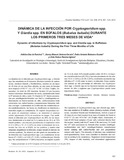Dinámica de la infección por Cryptosporidium spp. y Giardia spp. en búfalos (Bubalus Bubalis) durante los primeros tres meses de vida

View/
Date
2012-12-31Author
Palabras Clave
Cryptosporidium, Giardia, Bubalus bubalis, PrevalenciaCryptosporidium, Giardia, Bubalus bubalis, Prevalence
Metadata
Show full item recordAbstract
La dinámica de la infección por Cryptosporidium spp. y Giardia
spp. fue estudiada en 25 bucerros (Bubalus bubalis) de ambos
sexos, mestizos Murrah y Mediterráneo, nacidos en un lapso
de 45 días (d) en una finca ubicada en una zona de bosque
seco tropical a 9°42’17’’ LN y 70° 31’58’’ LO (Edo. Trujillo, Venezuela).
Un total de 250 muestras fecales (10 por bucerro)
fueron colectadas directamente del recto, semanalmente hasta
la 8ª semana de vida y cada 15 d hasta la 12ª, fueron procesadas
por centrifugación-flotación con NaCl y centrifugación-sedimentación
en formol-acetato de etilo, confeccionados frotis
coloreados con carbol-fucsina y preparaciones húmedas teñidas
con lugol. La intensidad de la infección fue establecida semi-
cuantitativamente, las heces se clasificaron en diarreicas y
normales según su consistencia. Se registró temperatura rectal,
grado de elasticidad cutánea y se determinó el volumen
celular aglomerado (VCA) en muestras de sangre. Fue confirmada
la infección por Cryptosporidium en 88% de los bucerros,
inicialmente a la edad de 5 d y antes de los 30 d, el 72%
resultó positivo. Las mayores prevalencias se registraron entre
8-14 d (36%) y 15- 21 d (32%) de edad, la intensidad de la infección
fue leve en el 63,6% de los positivos y cuanto más
temprano adquirieron la infección, mayor resultó el número de
colectas positivas. Se observó un alto grado de asociación entre
infección con Cryptosporidium spp. y la consistencia de las
heces (P < 0,001) y el VCA (P < 0,05). La infección por Giardia
spp. fue comprobada en 17 (68%) bucerros, se registró a partir
de 12 d de edad, 64% resultó positivo entre 29-35 d, la mayoría
con infección leve (83,5%) y fue más prevalente en las edades
15-21 d (32%) y 22-28 d (24%), mostrando asociación significativa
(P < 0,05) entre la edad y la infección. Estos resultados
indican un alto porcentaje de infección con Cryptosporidium
spp. y Giardia spp en los bucerros durante sus primeros
meses de vida y sugieren que Cryptosporidium puede tener
importancia clínica.
Collections
Información Adicional
| Otros Títulos | Dynamic of infections by Cryptosporidium spp. and Giardia spp. in buffaloes (Bubalus Bubalis) during the first three months of life |
| Correo Electrónico | adediazra@yahoo.com lilidor@ula.ve |
| Editor | SABER-ULA |
| ISSN | 0798-2259 |
| Resumen en otro Idioma | The dynamics of Cryptosporidium spp. and Giardia spp. infection was studied in 25 buffalo calves (Bubalus bubalis) of both sexes, crossbred Murrah and Mediterranean, born in a span of 45 days (d) at a farm located in an area of tropical dry forest to 9°42’17’’ LN and 70°31’58’’ LW (Trujillo State, Venezuela). A total of 250 fecal samples (10 per calf), collected directly from the rectum, weekly until the 8th week of life and every 15 d until the 12th were processed by formalin-ethyl acetate centrifugalsedimentation and NaCl centrifugal-flotation, manufactured smear staining with carbol-fuschin and wet preparations stained with lugol’s. The intensity of infection was established semi-quantitatively, feces were classified in diarrheic and normal according to its consistency. Registered rectal temperature (TR), degree of skin elasticity, and determined agglomerate cell volume (ACV) in blood samples. Infection was confirmed by Cryptosporidium in 88.0% of the buffalo calves, initially at 5 d of age and before 30 d old 72% was positive. The higher prevalence were registered among 8-14 d (36%) and 15-21 d (32%) old, the intensity of the infection was mild in the majority of animals (63.6%) and the more they acquire early infection, greater is the number of positive collections. A high degree of association was observed between Cryptosporidium spp. infection and fecal consistency (P < 0.001), and the ACV (P < 0.05). Giardia spp. infection was proven in 17 (68%) buffalo calves, recorded from 12 d old, 64% was positive between 29-35d, most presented mild infection (83.5%) and was more prevalent among 15-21 d (32%) and 22-28 d (24%) old, showing significant association (P < 0.05) between age of buffaloes calf and the infection. These results show a high percentage of infection with Cryptosporidium spp. and Giardia spp occurring in buffalo calves during its first months of life and suggest that Cryptosporidium might have clinical significance. |
| Colación | 507 - 515 |
| Periodicidad | Bimestral |
| País | Venezuela |
| Institución | Universidad del Zulia (LUZ) Universidad de Los Andes (ULA) |
| Publicación Electrónica | Revista Científica |
| Sección | Revista Científica: Medicina Veterinaria |





